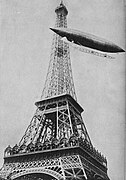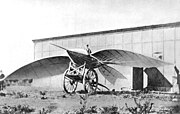Portal:Aviation
| Main page | Categories & Main topics |
|
Tasks and Projects |

Aviation includes the activities surrounding mechanical flight and the aircraft industry. Aircraft includes fixed-wing and rotary-wing types, morphable wings, wing-less lifting bodies, as well as lighter-than-air craft such as hot air balloons and airships.
Aviation began in the 18th century with the development of the hot air balloon, an apparatus capable of atmospheric displacement through buoyancy. Some of the most significant advancements in aviation technology came with the controlled gliding flying of Otto Lilienthal in 1896; then a large step in significance came with the construction of the first powered airplane by the Wright brothers in the early 1900s. Since that time, aviation has been technologically revolutionized by the introduction of the jet which permitted a major form of transport throughout the world. (Full article...)

...that the mysterious objects known as Black Triangles may actually be hybrid airships?

... that Wing Commander John Lerew, ordered to defend Rabaul against Japanese invasion in 1942, signaled headquarters the legendary gladiatorial phrase "We who are about to die salute you"?
- May 29: Austrian Airlines cancels Moscow-bound flight after Russia refuses a reroute outside Belarusian airspace
- August 8: Passenger flight crashes upon landing at Calicut airport in India
- June 4: Power firm helicopter strikes cables, crashes near Fairfield, California
- January 29: Former basketball player Kobe Bryant dies in helicopter crash, aged 41
- January 13: Iran admits downing Ukrainian jet, cites 'human error'
- January 10: Fire erupts in parking structure at Sola Airport, Norway
- October 27: US announces restrictions on flying to Cuba
- October 3: World War II era plane crashes in Connecticut, US, killing at least seven
- September 10: Nevada prop plane crash near Las Vegas leaves two dead, three injured
- August 6: French inventor Franky Zapata successfully crosses English Channel on jet-powered hoverboard
The following Wikimedia Foundation sister projects provide more on this subject:
-
Commons
Free media repository -
Wikibooks
Free textbooks and manuals -
Wikidata
Free knowledge base -
Wikinews
Free-content news -
Wikiquote
Collection of quotations -
Wikisource
Free-content library -
Wikiversity
Free learning tools -
Wikivoyage
Free travel guide -
Wiktionary
Dictionary and thesaurus
During his formative years Trenchard struggled academically, failing many examinations and only just succeeding in meeting the minimum standard for commissioned service in the British Army. As a young infantry officer, Trenchard served in India and in South Africa. During the Boer War, Trenchard was critically wounded and as a result of his injury, he lost a lung, was partially paralysed and returned to Great Britain. While convalescing in Switzerland he took up bobsleighing and after a heavy crash, Trenchard found that his paralysis was gone and that he could walk unaided. Some months later, Trenchard returned to South Africa before volunteering for service in Nigeria. During his time in Nigeria, Trenchard commanded the Southern Nigeria Regiment for several years and was involved in efforts to bring the interior under settled British rule and quell inter-tribal violence.
In 1912, Trenchard learned to fly and was subsequently appointed as second in command of the Central Flying School. He held several senior positions in the Royal Flying Corps during World War I, serving as the commander of Royal Flying Corps in France from 1915 to 1917. In 1918, he briefly served as the first Chief of the Air Staff before taking up command of the Independent Air Force in France. Returning as Chief of the Air Staff under Winston Churchill in 1919, Trenchard spent the following decade securing the future of the Royal Air Force. He was Metropolitan Police Commissioner in the 1930s and a defender of the RAF in his later years.

The Pregnant Guppy was a large, wide-bodied cargo aircraft built in the USA and used for ferrying outsized cargo items, most notably NASA's components of the Apollo moon program. The Pregnant Guppy was the first of the Guppy line of aircraft produced by Aero Spacelines, Inc. The design also inspired similar designs such as the jet-powered Airbus Beluga, and the Boeing 747 LCF designed to deliver Boeing 787 parts.
- 2012 – The first Solar Impulse aircraft, HB-SIA, the first solar-powered aircraft capable of both day and night flight thanks to its batteries charged by solar power, completes its first intercontinental flight, arriving at Rabat, Morocco, after a 19-hour flight across the Strait of Gibraltar from Madrid, Spain. The flight is the second and final leg of its intercontinental trip, which had begun on 25 May with a flight from its home base at Payerne Airport outside Payerne, Switzerland, to Madrid.[1][2]
- 2011 – NATO airstrikes level the offices of Libya's state television service, Libyan Jamahiriya Broadcasting Corporation, and the Libyan government military intelligence offices in Tripoli.[3]
- 2002 – Launch of Space Shuttle Endeavour STS-111 at 21:22:49 UTC. Mission highlights: ISS supply, crew rotation, Mobile Base System.
- 1991 – Launch of Space Shuttle Columbia STS-40 at 9:24:51 am EDT. Mission highlights: Spacelab mission.
- 1991 – A Royal Australian Air Force McDonnell Douglas F/A-18A Hornet, A21-041, of 75 Squadron, crashes 100 kilometres NE of Weipa, Queensland. The pilot was killed. The wreckage was found in July 1994.
- 1989 – The massive Antonov An-225 Mriya flies in to Paris-Le Bourget for the 1989 Paris Air Show, carrying the Soviet Shuttle Buran on its back. When it takes of from Kiev to fly to Paris, the combination has a takeoff weight of 1,234,600 lb, the greatest weight ever lifted into the air.
- 1969 – The Tupolev Tu-144 supersonic airliner becomes the first aircraft of its class to fly through the sound barrier when it exceeds Mach 1 at an altitude of 36,000 ft.
- 1969 – Rivet Amber, an RC-135E, 62-4137, operating out of Shemya AFB, went down in the Bering Sea. Despite a thorough search of the area, no wreckage and no survivors were ever found. The best theory is that the plane suffered some sort of catastrophic mechanical failure, as the last radio contact from the aircraft mentioned “vibration in flight”. Rivet Amber was returning to Eielson AFB for maintenance with a crew of 19 on board.
- 1969 – The American bombing of North Vietnam resumes after a seven-month pause.
- 1968 – North Vietnam demands an unconditional end to American bombing of its territory.
- 1967 – Boeing delivers its 1,000th jet airliner, a Boeing 707-120B for American Airlines.
- 1967 – June 5-10 – The Six Day War is fought between Israel and her Arab neighbors. In a pre-emptive strike, the Israeli Air Force destroys half of the Egyptian Air Force on the first night. By the end of the six days, 452 Arab aircraft had been destroyed for a loss of 46 Israeli aircraft.
- 1965 – The 1965 Fort Benning Mid-Air Helicopter Collision was a helicopter collision over Fort Benning, Georgia that left eighteen people dead. It occurred around 9:50 am.
- 1965 – The U.S. Navy begins full-time staffing of Dixie Station off South Vietnam by one aircraft carrier.
- 1965 – The U.S. Navy’s aircraft carrier presence in the Gulf of Tonkin off Vietnam reaches five ships.
- 1963 – President Kennedy announces that his administration would seek funds for the sponsored development of a supersonic transport aircraft.
- 1962 – A number three following RAF Hawker Hunter T.7 trainer (XL610) from No. 111 Squadron based at RAF Wattisham on a routine training flight flying in formation with two other aircraft crashes near Silk Willoughby, Lincolnshire, UK killing two crew members.
- 1958 – Second prototype Saunders-Roe SR.53, XD151, crashed during an abandoned take-off whilst testing at RAE Boscombe Down, killing its pilot, Squadron Leader John S. Booth, DFC. Project cancelled.
- 1956 – A USAF Northrop F-89 Scorpion fighter jet of the 18th Fighter-Interceptor Squadron armed with 104 live rockets, strikes an automobile during an aborted take-off at Wold-Chamberlain Field, Minneapolis, Minnesota, United States, killing three of the five occupants of the vehicle; both F-89 crew members survive.
- 1952 – Exercise Bluebird: a Royal Netherlands Air Force Republic F-84 Thunderjet collided with the mast of the British Royal Navy motor launch HMML 2582 and crashed onto the deck in flames. The launch sank with the loss of fifteen crew and the pilot of the Thunderjet. The accident occurred in the Marsdiep, Netherlands.
- 1951 – The U.S. Air Force, Navy, and Marine Corps begin Operation Strangle, a day-and-night air interdiction campaign against enemy roads, bridges, and tunnels across the width of the Korean Peninsula between 38 degrees 15 min North and 39 degrees 15 min North. It will continue until February 1952, but without the success hoped for it.
- 1950 – RCAF Colours were presented to the Force by the Governor-General, Field Marshal Earl Alexander of Tunis, at Ottawa, Ontario.
- 1948 – Northrop YB-49-NO, 42-102368, c/n 1488, crashes in desert near Muroc Air Force Base, California after both outer wings become detached from center section during spin recovery, killing pilot Maj. Daniel Forbes, co-pilot Capt. Glen Edwards, and three crew. Forbes Air Force Base, Kansas, is named for the pilot, and Muroc is renamed Edwards Air Force Base for the co-pilot on 5 December 1949. Flying wing bomber design will be revived in the 1980s as the B-2 Spirit.
- 1945 – A typhoon strikes U.S. Navy Task Force 38 southeast of Okinawa. The aircraft carriers USS Hornet (CV-12), USS Bennington (CV-20), USS Belleau Wood (CVL-24), USS San Jacinto (CVL-30), USS Windham Bay (CVE-92), and USS Salamaua (CVE-96) are damaged and the task force loses 76 aircraft.
- 1944 – Two Japanese bombers make a destructive strike against about 100 Allied aircraft paired wingtip-to-wingtip at Wakde, putting the base out of action for several days.
- 1944 – The B-29 Superfortress flies its first combat mission; 98 B-29s take off from bases in India and attack railroad shops in Bangkok, Thailand. Five are lost, none to enemy action.
- 1944 – June 5-6 – "D-Day" – The Allied invasion of France is spearheaded by paratrooper drops and assault glider landings.
- 1943 – In a battle over the Russell Islands between 81 Japanese Mitsubishi A6 M Zero fighters and 110 Allied aircraft, the Japanese lose 24 aircraft in exchange for seven U.S. fighters.
- 1931 – C.W.A. Scott breaks the record for the fastest solo flight from Australia to England, flying the 10,660 miles (17,160 km) from Wyndham, Australia to Lympne, England from May 26 to in 10 days 23 hours piloting a DH.60 Moth (Gipsy II).
- 1927 – The Verein für Raumschiffahrt ("Society for spaceship travel") is formed in Germany.
- 1918 – Douglas Campbell, the first American to become an ace while flying for an American unit, scores his sixth and final victory. Badly wounded during the flight, he sees no further combat.
- 1917 – The United States Navy’s First Aeronautical Detachment disembarks from the collier USS Jupiter in France under the command of Kenneth Whiting. It is the first U.S. military unit to arrive in Europe.
- 1909 – The first monoplane flight of over one hour is made by Englishman Hubert Latham on the Antoinette IV for one hour, seven minutes, 37 seconds.
- 1909 – John Berry and Paul McCullough win the U.S.’s first National Balloon Race, covering 377.9 miles – from Indianapolis, Indiana to Fort Payne, Alabama – in 25 hours 35 minutes.
- 1909 – First flight of the Roe I Triplane
- 1783 – Unmanned flight of the Montgolfier brothers hot-air-balloon (Montgolfière) in Vivarais, France. The Montgolfiers demonstrate a hot air balloon in public, at Annonay.
References
- Shortcuts to this page: Portal:Airplanes • P:AVIA



















































